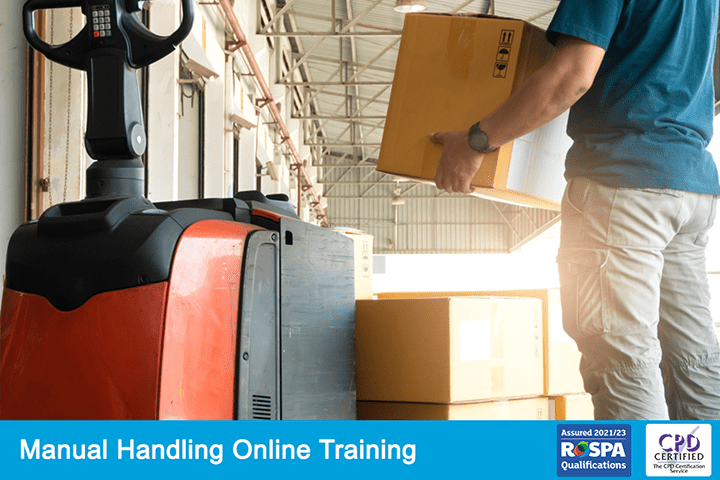Manual handling includes lifting, carrying, pushing and pulling objects. It is a common task in many workplaces, but if you do it incorrectly it can lead to serious injuries.
Unfortunately, many workers use the wrong approach when carrying out manual handling activities. The latest Health and Safety Executive’s report on health and safety at work shows that handling, lifting or carrying is the second most common cause of injuries at work. It accounted for 17% of all non-fatal workplace injuries in 2022/23.
Common Manual Handling Mistakes to Avoid
Here are seven common manual handling mistakes that you should avoid to remain safe when lifting, carrying, pushing or pulling objects at work.
1. Using incorrect lifting technique
Perhaps the most common mistake workers make when lifting heavy objects is incorrect lifting technique. For example, people often arch their back when they bend over to lift an object. If you lifting a heavy object incorrectly, you can put your body under excessive stress. This can cause immediate damage to muscles and tendons and it can cause longer term musculoskeletal disorders.
To lift safely, position your body close to the object, bend your knees keeping your back straight, get a good grip and use your leg muscles to lift it. This allows you to lift with the larger muscles in your legs instead of the smaller muscles in the lower back. It limits strain and prevents possible sprains or other injuries.
2. Lifting heavy or awkwardly shaped objects without assistance
Another mistake workers tend to make is underestimating the weight or size of an object they intend to lift. Lifting or carrying objects that are too heavy or awkwardly shaped can put a strain on your back and other muscles, leading to injuries. It also increases the risk of dropping the item and causing potential harm to yourself or your colleagues.
Before you attempt a lift, make sure that you are aware of the item’s weight and shape, and know what your limit is. If it is too heavy, or it is an awkward shape that prevents you from getting a good grip, ask for assistance. Shared lifting helps to spread the weight between you and allows you to have a better grip on awkwardly shaped items.
3. Twisting while you lift
If you twist your back or lean sideways while lifting, lowering, pushing or pulling a load, this can cause serious injury to your back. If you need to turn, first lift the item using correct lifting technique and hold it close to your body. Then turn by moving your feet while keeping your hips and shoulders in the same direction. Similarly, if you need to put down an object, first turn by moving your feet and lower the object by keeping your back straight and bending your knees. Also, avoid twisting your back or leaning sideways when pushing or pulling a load.
4. Not taking regular breaks
You should take regular breaks when you carry out manual handling at work. Manual handling tasks can be physically demanding, and it is important to take short regular breaks and to vary tasks so that you can rest and recover. This will help to prevent fatigue and reduce the risk of injuries.
5. Not using mechanical aids
You should use mechanical aids for manual handling if they are available. Lifting or carrying objects that are unstable, unbalanced, or hard to hold may lead to uneven loading of the muscles. This can cause muscle fatigue as the centre of gravity of the object may not be in the middle of your body. Mechanical aids such as trolleys, sack trucks, pallet trucks, cages, barrows or dollies can reduce the risk of injuries from carrying unstable, unbalanced, or hard-to-hold items. Also, mechanical aids can significantly reduce the risk of injury when moving heavy objects over a long distance. These aids support the object’s weight and make moving easier without putting excessive strain on the body. It is important to use the equipment provided by your employer and to use it correctly.
6. Not inspecting the area
It is important to inspect the area before you carry out manual handling. Poor lightning, obstructions in your path and uneven, slippery or wet floor surface can increase a risk of falling over or dropping a load. So it is important to take a moment and inspect the area before you begin any manual handling task. This helps to identify any potential hazards or obstacles that could cause an accident.
7. Lack of training
Finally, make sure you take part in appropriate manual handling training. A lack of proper manual handling training is one reason why so many people sustain manual handling injuries at work. Workers who do not have a proper training may be unaware of manual handling risks. This can mean that they fail to assess a load, do not follow correct manual handling technique, apply incorrect posture, and overlook the importance of asking for help or using mechanical aids.
Manual handling training equips workers with the knowledge and skills they need to move loads at work safely.
For more information on how to ensure safe manual handling at work, read our article The 5 key principles of Manual Handling.
How i2Comply Can Help
So, how can i2Comply help? Well, we offer excellent, high quality, affordable, training courses. Our online Manual Handling training course is RoSPA-assured and CPD-certified. By making sure employees are properly trained, businesses can ensure that their workplace is safer, more productive and compliant with legislation.




